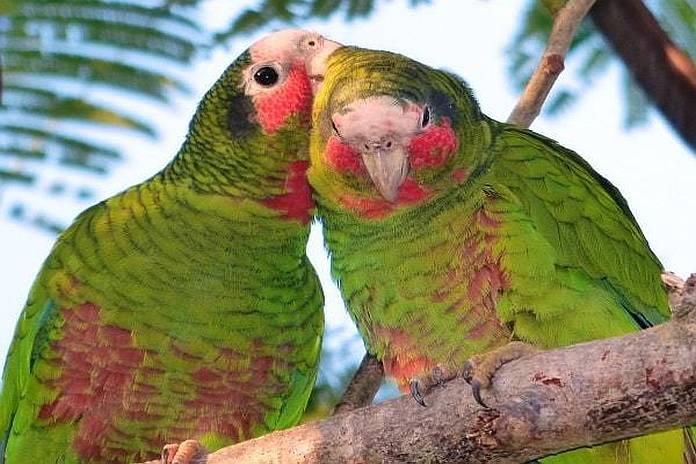
Development poses growing threat to parrots
GEORGE TOWN, Cayman Islands (CNS) – The continued clearing of land for development in the Cayman Islands is posing an increasing threat to its endemic parrots. Adding to the problem of poaching, the ongoing impact on the National Birds' habitat is making them less resilient, according to the Department of Environment.
With the hurricane season now underway, a major storm could undermine the survival of parrots on both Grand Cayman and Cayman Brac, and the DoE is urging people to consider the conservation of the unique birds and help preserve their natural habitat.
Hurricane Ivan on Grand Cayman and hurricane Paloma on Cayman Brac both took a serious toll on the populations of Cayman parrot species, both sub-species of the Cuban Parrot (Amazona leucocephala). While the numbers have recovered, the DoE is concerned that they are now much more vulnerable to depletion from a major hurricane.
'We lost an estimated 50-60 percent of our parrot population during 2004's Hurricane Ivan, and more than half of the parrots on Cayman Brac during 2008's Hurricane Paloma,' said DoE Terrestrial Resources Unit Manager Fred Burton. 'Over time, the Grand Cayman parrots made it back to pre-Ivan levels. The Brac parrots took about five years to recover from the effects of Paloma.'
Population assessments by the DoE since those major hurricanes revealed that the parrots are now concentrated in smaller areas on both Cayman Brac and Grand Cayman. The studies also suggest a lower number of breeding parrot pairs on both islands. Grand Cayman parrots (Amazona leucocephala caymanensis) are now mostly restricted to the central and eastern mangroves and dry forest.
Breeding of the Cayman Brac parrot (Amazona leucocephala hesterna) now mainly occurs in the dry forest on the Bluff. This species once inhabited Little Cayman but stopped breeding following the disastrous 1932 storm, which largely destroyed their breeding grounds. The Brac parrot's home range is now among the most limited of any Amazon parrot subspecies in the world.
'Stresses on the population from clearing of natural habitats and also from unlawful poaching have made our Cayman parrots less able to come back from major losses experienced during hurricanes or tropical storms,' said DoE Research Officer Jane Haakonsson, noting that Cayman parrots are a protected species under the National Conservation Law (NCL).
Cayman has not yet been required to adopt captive breeding measures in attempts to boost the parrot numbers, as has occurred in Puerto Rico, where hundreds of thousands of dollars have been spent preserving the local species. But after reestablishing the population, the species was depleted again following hurricanes Irma and Maria in 2017.
'Puerto Rico lost a huge number of its re-established native parrots during the 2017 storms,' said Jafet Vélez, wildlife biologist at the Puerto Rican Parrot Recovery Program.
'The captive breeding efforts needed to support the remaining population are both expensive and time-consuming. It is far better, in the Cayman Islands situation, to conserve what natural habitats remain and try to curb such issues as poaching of the birds.'
Even environment minister Dwayne Seymour, whose support for and understanding of conservation has frequently been called into question since he was given the portfolio, said that Cayman would not want the expense that other countries have incurred with captive breeding efforts.
'Let's ensure Cayman parrots can safely remain in their natural habitat,' Seymour stated in a release from the DoE.
Republished with permission of Cayman News Service

Legal Disclaimer:
MENAFN provides the information “as is” without warranty of any kind. We do not accept any responsibility or liability for the accuracy, content, images, videos, licenses, completeness, legality, or reliability of the information contained in this article. If you have any complaints or copyright issues related to this article, kindly contact the provider above.
Most popular stories
Market Research

- Manuka Honey Market Report 2024, Industry Growth, Size, Share, Top Compan...
- Modular Kitchen Market 2024, Industry Growth, Share, Size, Key Players An...
- Acrylamide Production Cost Analysis Report: A Comprehensive Assessment Of...
- Fish Sauce Market 2024, Industry Trends, Growth, Demand And Analysis Repo...
- Australia Foreign Exchange Market Size, Growth, Industry Demand And Forec...
- Cold Pressed Oil Market Trends 2024, Leading Companies Share, Size And Fo...
- Pasta Sauce Market 2024, Industry Growth, Share, Size, Key Players Analys...





















Comments
No comment